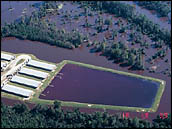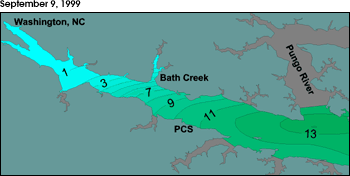

 |
|||
Within days after Hurricane Floyd, North Carolina officials feared the worst
for its coastal and estuarine ecosystems. Floodwaters flushed the contents of
fuel tanks, pig waste lagoons, and human sewage treatment plants into the
state’s rivers and sounds and, ultimately, out into the Atlantic Ocean. The
carcasses of pigs, chickens, and other dead animals floated in the soup of
pesticides, fertilizer, and topsoil carried in the massive runoff. Even the
sheer volume of the freshwater itself was a threat to the plant and animal
species that prefer brackish or salt water. |
Hurricane Floyd Series:
| ||
Garcy Ward, environmental specialist with the Pamlico Rapid Response Team, said there was concern among scientists that any number of these pollutants would cause massive fish kills. His team’s job is to monitor daily the river’s health by making a whole suite of in situ measurements and firsthand observations. They routinely measure temperature as well as oxygen and salinity levels at multiple sites along the Pamlico. But they were also on the lookout for signs of anomalous algae blooms, unusually high levels of bacteria, or even Pfiesteria (a toxic dinoflagellate that has multiple life forms in which it can feed off sunlight, algae, and even the living tissue of fish and shellfish). "People were afraid the runoff would fuel an algae bloom, but it never
happened," Ward observed. "We did see a small fish kill in a small,
isolated pocket off the Pamlico River. It was a mixed bag of fish--spot, bass,
some menhaden. But this is not unusual, and it was hard to pinpoint the cause of
death because they had been dead a couple of days when we found them. It’s
possible they were killed by low oxygen levels." |
Flood runoff in the aftermath of Hurricane Floyd carried an immense load of sediment—including soil, sand, sewage, fertilizer and pesticides—into the sea. This image, from the Sea-viewing Wide Field of View Sensor (SeaWiFS) on September 23, 1999, shows the sediments being swept into the Atlantic by the Gulf Stream. (Image courtesy SeaWiFS Project, NASA GSFC) | ||
Ward’s team observed that both salinity and dissolved oxygen levels quickly dropped to almost zero in the days following Floyd. He explains that there are two main factors that can cause low oxygen: (1) outflow from swamps and (2) decomposing organic matter in the flood runoff. Swamp waters tend to have low dissolved oxygen because they are rich in decomposing organic matter (the process of bacterial decomposition uses up a lot of oxygen). Outflow from eastern North Carolina’s swamps mingling with river and estuarine waters probably helped bring down oxygen levels. Also, there was a lot of organic matter in the runoff, both carried from sources of human and animal waste as well as vegetation sloughed off from river banks and flooded lands. Again, bacterial decomposition of these organic materials sucked oxygen from the water. But Ward says the biggest single impact was the decrease in salinity levels. "Prior to the storm, salinity levels in the Pamlico River were the highest I had seen in a long time," he notes. "1999 was a bad drought year with low rainfall and high temperatures." Typical summertime
salinity levels in the Pamlico are anywhere from 6 to 10
parts (of salt) per thousand (parts of water). But as recently as August, due to
the drought, the salinity level crept up to 14 parts per thousand.
Before Hurricane Floyd, shrimp industry officials were predicting a very high
harvest--shrimp prefer saltier water and conditions were certainly right in the
rivers and estuaries. Then came the massive outflow of highly polluted
freshwater and, almost overnight, the expectation changed to one of total loss.
Whereas the dissolved oxygen levels recovered in a matter of weeks, it took
several months for salinity levels to return to normal levels. |
 Overflowing rivers in the aftermath of Hurricane Floyd flooded many storage lagoons that contained livestock sewage. The resulting runoff carried animal waste and threatened the health of estuaries along the Atlantic coast. (Photograph courtesy U. S. Geological Survey Center for Integration of Natural Disaster Information) | ||

North Carolina is home to about 8,000 commercial fishermen and the fishing industry is a vital part of the state’s economy. So, in December, industry representatives met with Governor Jim Hunt and state legislators to establish a $11.4 million relief plan to offset the anticipated $19 million impact to the 1999 harvest. Ironically, by the time that meeting was held, fishermen were catching record numbers of shrimp and crabs off the Carolina Coast. |
| ||